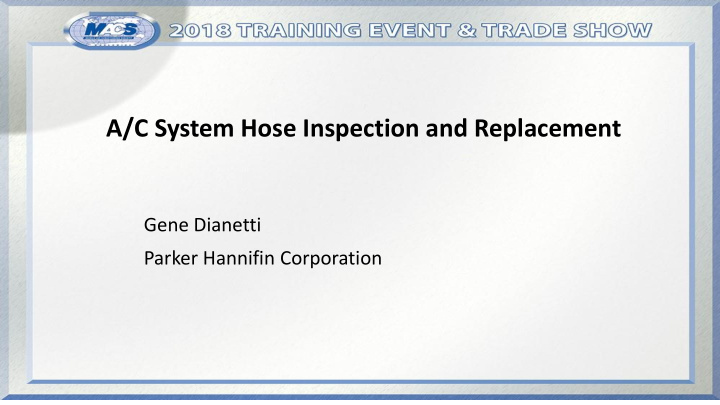



A/C System Hose Inspection and Replacement Gene Dianetti Parker Hannifin Corporation
A/C System Hose Inspection and Replacement A/C hose and tube assembly replacement / repair may be an opportunity to solve original design / installation issues. This presentation will illustrate some of these issues Best practice or design guidelines will hopefully assist in root causing and permanently solving these issues System performance and component life may significantly be increased by making improvements to original installation!
Table of Contents • Routing Issues • Parts returned for analysis • Hose Rub through • Too Close to Heat Sources • Hose Kinking • Tube Rub Through • Sleeves / clamps / clips to prevent abrasion / excessive heat failures • Hose Bend Radius • Hose Crimping • Design Standards • System Efficiency • Pressure Drop Concerns • Oil return / trapping • Insulation • Summary
There should be no contact Contact between the hoses
Hose Rub Through
Retractable Cab Applications, i.e. Skid Steer Retractable driver seat access For engine area for service Must be careful to keep A/C line From pinching, rubbing or laying On any hot surfaces
Hose Rub Through
Too Close to Heat Source
A/C Line Rubbing
Tube Rub Through
Sleeves Prevent Abrasion / Heat Issues Sleeves to prevent damage from abrasion contact Heat Sleeve
Clamps / Straps Secure Hoses / Tubes to Prevent Contact P- Clamp Dual Tie Strap Hose/ Tube Clamp
Hose Kink Due to Routing
Issue: hoses leaning against turbo. Issue: A/C line kinked
Excessive Bending at Hose Crimp Nipple HOSE CORE TUBE IS CUT
Too Much Twist causing Hose Collapse / Pressure Drop
Understand Hose Spec’s on Bend Radius
Hose Crimping Good hose couplings Excessive crimping No Worm gear clamps! have specified causes nipple components and crimp collapse and potential dies – Do not mix! refrigerant leak Use of correct fittings, proper crimping dies and dimensions as specified by each manufacturer. Do not use Company A components and Company B crimp!
Required Test Equipment SAE J2064/J3062 Burst Stand Tensile Tester Constant Temp Ovens Thermal Chamber Moisture Ingression Stand Refrigerant Charging and Reclaim
Design Guide For Tube Bend Radii BEND RADII MINIMUM: 3/8” tube O. D. Minimum of 5/8” (3/4” Preferred) 1/2” tube O. D. Minimum of 3/4” 5/8” tube O. D. Minimum of 1” 3/4” tube O. D. Minimum of 1 ¼ (1 ½” Preferred) 1” tube O. D. Minimum of 2” Why? Prevent tube flattening which can cause restriction / pressure drop
Design Guide For Bend Tangents BEND TANGENTS: Shell to Tangent of Bend - Minimum of 5/8” straight from any edge on the 3/8” through 5/8” tube O. D. Minimum of 3/4” straight from any edge on 3/4” tube O. D. Tangent-to-Tangent - End of one bend to start of another bend, minimum of 1” straight. Tangent-to-back of nut or block - Minimum of 5/8" straight length Why? Keep from bending too close to braze/weld joints Prevent tube cracking or flattening
System Efficiency - Pressure Drop • Pressure Drop • Excessive low side pressure drop can decrease performance • Cause higher than design saturated evaporator pressure / temperatures • Causes • Undersized suction line / hose • Hose twist • Hose kink • Excessive tube bends • Flattening of the tubes during bending
System Efficiency - Oil Return / Trapping • Variable Compressor Systems • Little oil leaves the compressor during operation • Fixed Displacement (FD) Compressor Systems (Piston / Scroll) • Rely on oil circulation with refrigerant • Can be sensitive to oil trapping in the low side during low load (low refrigerant velocity) situations • Minimize potential oil “traps” with suction hose assembly routings • High Mounted Compressors (FD) May Be Sensitive to Hose Routings • Extended off cycle oil migration – “Oil Washing” effect • Depends upon relative position of each component in the system
System Efficiency - Insulation Foam Sleeve Asphalt Tape
SUMMARY • When servicing A/C systems, examine the layout and root cause problem. Use proper techniques / practices when making improvements to correct the issue. • Follow recommended design standards to avoid hose kinking, tube flattening or cracking which will cause system breakdown and poor performance • A/C Hose assemblies are normally routed in tight spaces. Avoid contact points and keep away from high heat sources. Use clamps, clips and sleeves to protect the assembly. Insulation may improve performance by isolating heat sources from the suction line • Select qualified repair components and assembly techniques which meet the requirements of the OEM manufacturer and industry standards (SAE). • Continue learning and applying best practices when servicing A/C systems to maintain high quality levels
Thank You! Contact Information: Gene Dianetti Parker Hannifin Hose Products Division gdianetti@parker.com
Recommend
More recommend